Year: 2017
2018北美隧道会议
行业活动: 2018 北美隧道会议
活动日期: 2018年6月 24-27日
城市: 美国,华盛顿
地点: 华盛顿华德曼公园万豪酒店
罗宾斯公司期待着在6月24日至27日在华盛顿举行的2018年北美隧道会议与您见面。请前来317号展位,了解更多关于成功和令人兴奋的隧道工程。
2018世界隧道峰会
Event Name: WTC 2018
Dates: April 21-26, 2018
Location: Dubai, United Arab Emirates
Venue: Dubai World Trade Centre
The Robbins Company will be attending ITA-AITES World Tunnel Congress 2018 in Dubai, United Arab Emirates, April 21 through 26. Be sure to visit us at stand 70-71 between April 23 through 25 to learn more about Robbins TBMs operating world-wide.
Robbins Presentations
Monday, April 23
14:20 – 14:40 Robbins Vice Present Doug Harding, “Excavating Turkey’s Hardest Rock at the Bahce-Nurdag Railway Tunnel”
Wednesday, April 25
9:40 – 10:00 Robbins Director of Engineering Brad Grothen, “Excavating Turkey’s Most Challenging Project – The Gerede Water Transmission Tunnel”
12:15 – 12:35 Robbins Mexico Managing Director Roberto Gonzalez, “Excavating Mexico City’s Mega-Tunnel in Mixed Ground at 150 Meters Deep: Emisor Oriente Wastewater Tunnel Lot 5”
2018北美非开挖技术峰会
Event Name: NASTT’s No-Dig Show 2018
Dates: March 25-29, 2018
Location: Palm Springs, CA, USA
Venue: Palm Springs Convention Center
The Robbins Company is looking forward to seeing you in Palm Springs, CA for NASTT’s No Dig 2018 March 25 through 29. Visit booth 470 during exhibit hours to discover how renting or owning a Robbins Small Boring Unit (SBU) can save you time and money on your next boring project.
墨西哥全国土木工程师大会
Event Name: Congreso Nacional de Ingenieria Civil
Dates: March 1-8, 2018
Location: Mexico City, Mexico
Venue: World Trade Center
Join The Robbins Company at Congreso Nacional de Ingenieria Civil March 1 through 8, in Mexico City, Mexico. Visit our booth to learn more about current techniques being used on Robbins projects throughout the world.
2018地下施工技术峰会
Event Name: Underground Construction Technology (UCT) 2018
Dates: January 30-February 1, 2018
Location: New Orleans, LA, USA
Venue: Ernest N. Morial Convention Center
The Robbins Company will be attending Underground Construction Technology 2018 January 30 through February 1. Be sure to visit our booth to learn more about Robbins Small Boring Units (SBUs)—the most cost effective and time efficient way to bore through hard rock.
这一季度世界各地的工地发生了什么?
At any given time, Robbins TBMs are operating at dozens of jobsites around the world. Our dedicated Field Service personnel take video and pictures of the TBM progress often, so we’ve decided to offer a quarterly roundup of what’s going on in picture and video format–from deep TBM assembly in New York, USA to an epic TBM launch in the Himalayan mountains of Nepal. Read on to found out the latest.
TBM Assembly in a Deep Shaft in New York, USA
A 6.8 m (22.3 ft) Robbins Single Shield TBM, designed for water pressures up to 20 bar, is undergoing assembly and testing at the Delaware Aqueduct Repair Project. The TBM will be launched from a starter tunnel at the bottom of a 274 m (900 ft) deep shaft.
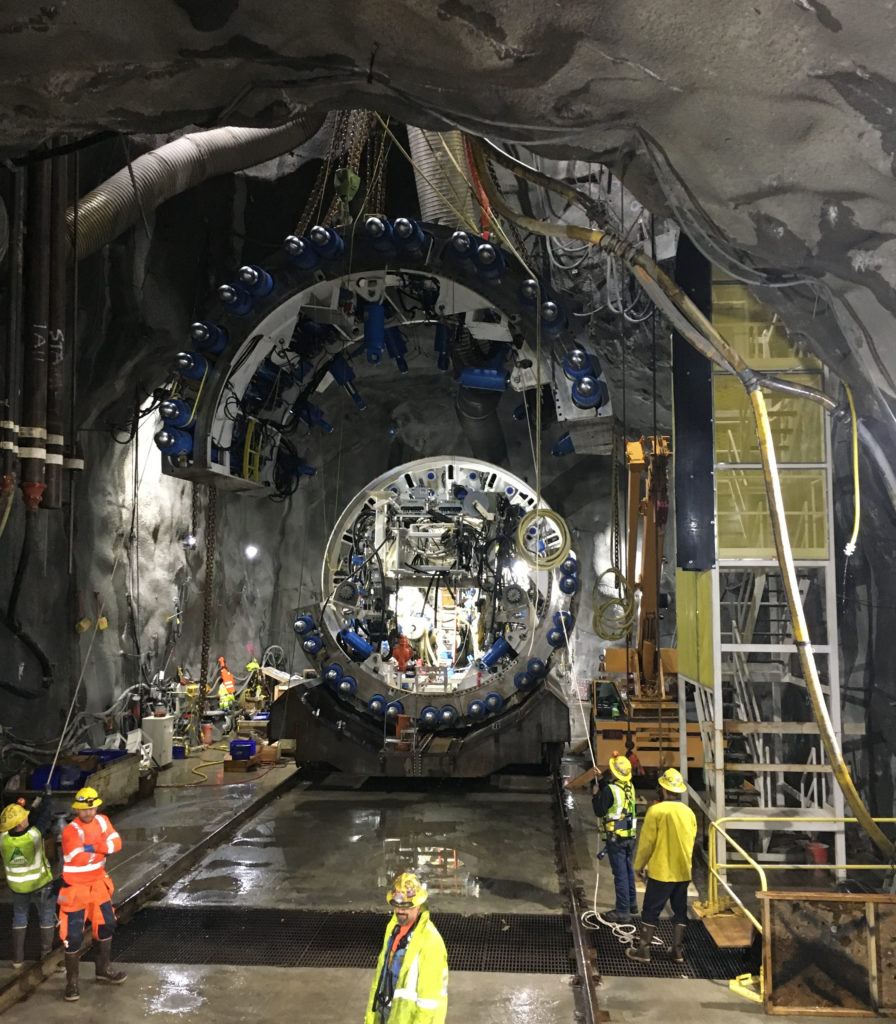
TBM Assembly at the Delaware Aqueduct Repair in Newburgh, New York, USA. The shaft is an incredible 274 m (900 ft) deep.
TBM Assembly Time Lapse
Epic TBM Launch in the Himalayan Mountains
In the Siwalik Range of the southern Himalayan Mountains of Nepal, a 5.06 m (16.6 ft) Robbins Double Shield embarked to bore the Bheri Babai Diversion Multipurpose Project (BBDMP). The TBM launched on October 14. See the drone footage taken by our own Field Service TBM Mechanic Thomas Fuchs:
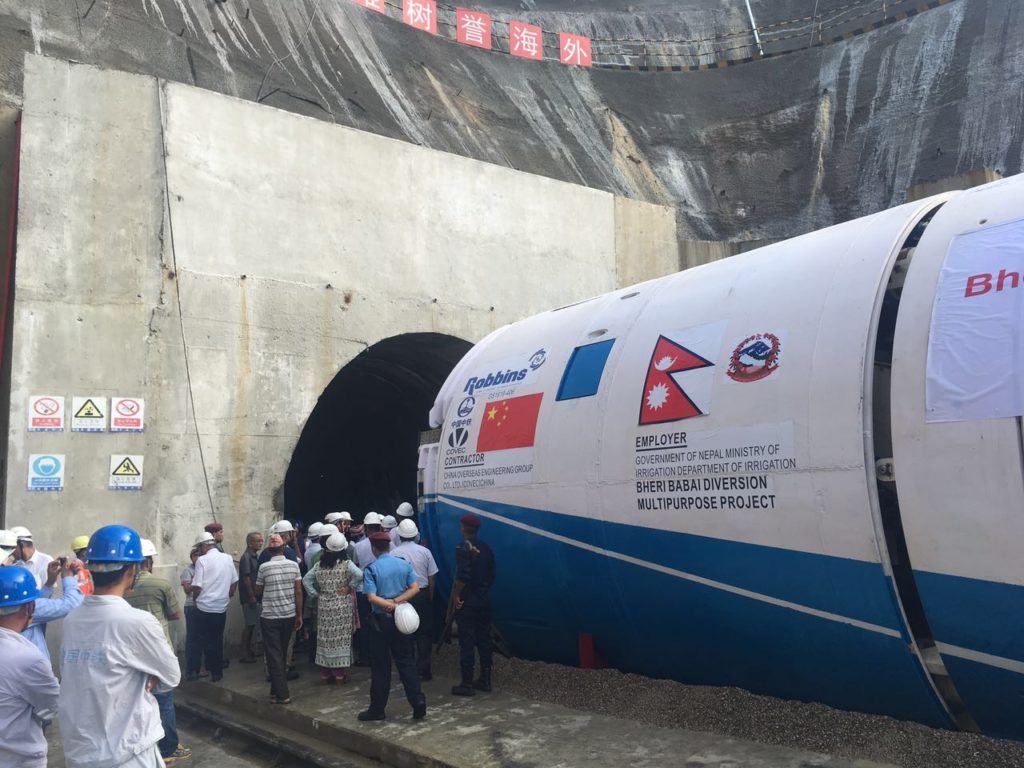
Launch of the Robbins Double Shield at Nepal’s BBDMP on October 14.
Crossover Machine Startup in Akron, Ohio
On October 19, a Robbins 9.26 m (30.4 ft) diameter Crossover (XRE) TBM launched below Akron, Ohio, USA to bore the OCIT tunnel. The machine is excavating in soft soils that will transition into mixed face and then full face shale. Before its launch, personnel at the jobsite filmed the cutterhead testing in a unique way. Watch the video below for more:
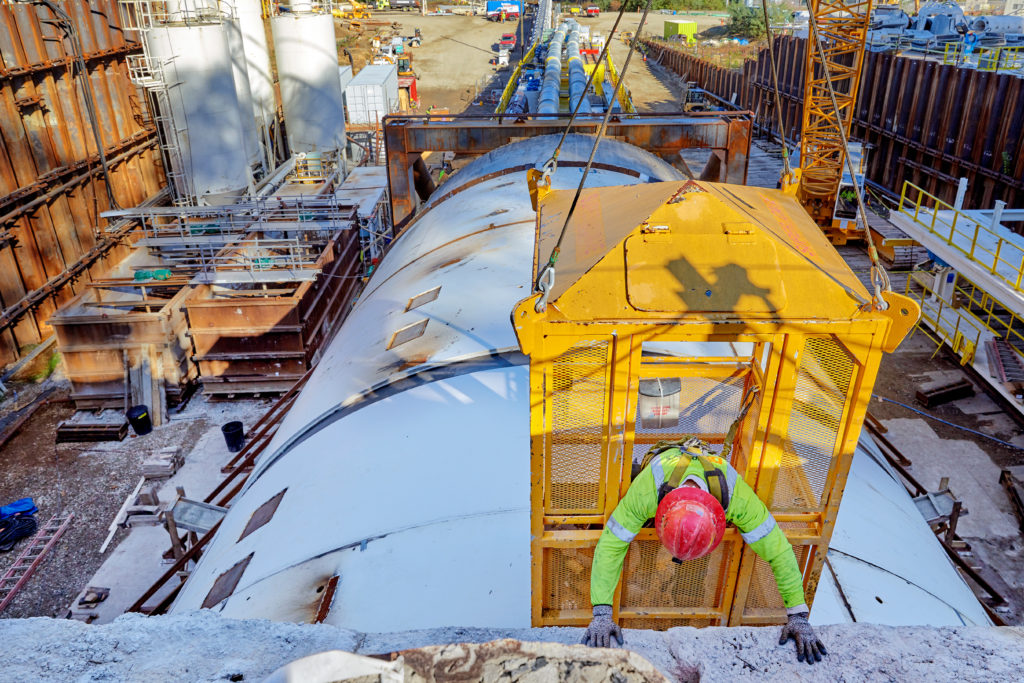
A worker surveys the TBM prior to its launch on the Akron OCIT October 19.
坚固的罗宾斯盾构机为金奈地铁项目完成第三次开挖
2017年10月31,直径6.65米罗宾斯盾构机贯通了钦奈地铁隧道,这是这台机器为承包商Afcons基础设施有限公司在这个项目中贯通的第三段隧道。采用这台盾构机开挖三段独立的隧道是一个增长趋势,许多罗宾斯盾构机重复使用于多个项目都有十分好的性能表现。罗宾斯盾构机比市场上其他盾构机重量多重1/3倍,其设计的使用寿命为10,000小时。这让他们成为在可以开挖许多公里数的理想设备。“罗宾斯的设备也以适用性强闻名,”承包商Afcons高级经理Gopal Dey说道。“为这个项目,我们需要的机器,具体来说是为项目的地质条件从粘土到混合地质到硬岩地质量是定制的。罗宾斯盾构机有独特为地质优化的设计特点。”
在完成其原来的两条隧道后,盾构机进行了翻新,准备开挖其最新的长1.8公里路段。在翻新过程中,内密封润滑系统由自动切换到手动模式,并对泡沫喷嘴系统进行了改造。这些变化使机器在前两个隧道遇到的高度可变的混合面条件下进行了优化。
这台盾构机于今年早些时候于2月3日始发。根据承包商AFCONS的说法,这台机器面临着一个巨大的挑战。AFCONS总监Manivannan先生说:“当掘进机从始发井出来时,安装了几个环,然后机器必须穿过一条带电的铁路轨道,这意味着有可能发生地表沉降。在这一阶段,我们必须密切监测掘进机的工作面压力,以均匀的速度推进机器,以确保适当的一次注浆。”掘进的地质主要由粘土砂和大约60米的混合地质组成。
Dey说:“我们(AFCONS)之所以选择这台机器是因为钦奈的地下地质情况不断地从土壤变为混合地质。我们还喜欢罗宾斯盾构机的主动铰接系统设计,使机器能够轻松转动或转向。”在主动铰接下,推力油缸对隧道衬砌的整个圆周均匀作用,即使是在曲线隧道,这种设计消除了隧道衬砌变形的问题。”这一特性使机器能够在良好的控制条件下穿越隧道,” Manivannan补充说。
在开挖所有三条隧道中,罗宾斯现场服务人员都在现场,根据需要提供协助和支持。在每次掘进过程中,罗宾斯都会向AFCON建议如何在具有挑战性的地面上进行最佳操作,并为机器操作提供指导。正如罗宾斯和AFCON在整个合同中所说,承包商和制造商的良好合作能力对良好的掘进率至关重要。其结果是一个强大的机器,在具有挑战性的条件下以每分钟80毫米的速度前进。
这条最新的隧道连接了地铁沿线的多个车站,从Washermenpet到Sir Theagaraya和Kurukpet。金奈地铁项目将为快速发展的城市提供急需的交通工具。
2017土耳其隧道展
Event Name: Tunnel Turkey 2017
Dates: December 2-3, 2017
Location: Istanbul, Turkey
Venue: Wyndham Grand Istanbul Levent Hotel
The Robbins Company will be exhibiting at the 2017 International Tunneling Symposium, also known as Tunnel Turkey, in Istanbul December 2-3. In keeping with this year’s theme, “Challenges in Tunneling,” stop by stand S-4 to learn more about how Robbins overcomes our own challenging projects.
During the conference, be sure to attend, “Use of dual mode, crossover TBM to excavate challenging geology at Mexico City’s Emisor Poniente II Waste Water Tunnel” presented by Robbins Public Relations Manager, Desiree Willis. The presentation will take place on Saturday, December 2 at 2:00 pm.
罗宾斯第一百台连续输送机
2017年10月18日,为美国俄亥俄州开挖阿克伦俄亥俄运河拦截隧道(Akron OCIT)的一台直径为9.26米的大直径跨模式掘进机始发。但这个始发并不是唯一的里程碑。在跨模式掘进机后运行用于出渣的,是第100台罗宾斯连续输送系统。侧置式输送机是一种设计标准,但它的里程碑意义重大:“这台输送机的诞生,让我们成为供应输送机数量最多的掘进机输送机供应商,”罗宾斯输送机、刀具及小型掘进机分布总裁Dean Workman说道。Workman补充说,罗宾斯按订单计算输送机的数量,包括准备发货的,数字现在已经超过了100台。
Akron OCIT输送机系统包括皮带+主驱动、插接机架、存储部件,以及前进尾件,通过几条曲线运行,配备具有专利的自调式曲惰轮,根据不同的皮带张力和皮带负荷进行校正运行。该系统会把渣土排放到定制的地面输送机,然后再把渣土送往入口附近的一个大型堆场。这条输送带设计用于处理多变地质,从软土到部分面岩,最后是全段面页岩。
在罗宾斯几十年来不断完善和改良,第100台输送系统已经被翻新和定制。“我们设计的输送机系统可以工作5到10年,但很多都工作了几十年。”我们有系统采用已经运行了30年的组件。我们的许多系统还没有达到一个极限——例如,我们很特别的输送机系统,十多年前为澳大利亚悉尼的Parramatta铁路连接隧道上制造。这些组件在佐治亚州亚特兰大的项目得到了翻新,现在他们又在印第安纳州印第安纳波利斯的挖掘隧道中使用。这些都是很长很有挑战性的隧道驱动器,组件都是由它决定的。虽然Akron OCIT输送机刚刚开始运输淤泥,但在整个项目的不同地面条件下,它肯定会受益。
在阿克伦的输送机也是罗宾斯输送带的历史的一部分,这个产品是第一台在掘进机后使用的连续输送系统。该原型机由创始人詹姆斯·S·罗宾斯(James S. Robbins)于1963年发明,在当时被称为西巴基斯坦的曼格拉大坝项目中成功地在直径11.2米的主梁式掘进机中使用。虽然输送带在发明后来的多年没有被作为一种标准的出渣方法,但这个项目为未来的成功奠定了基础。
今天的输送机系统可以跨越几十公里,运输量达1800吨(2000吨)一个小时或更多。Workman认为这个历史遗产会继续发扬光大:“这是我与罗宾斯的第20年,我还记得我们开始我们着手记录传送机的名单。看着所有的付出和成果,真是太棒了。看到这些系统完成不同的项目任务真是太棒了。
在蓝山下掘进:世界最快的掘进机的内幕故事
Over 20 years ago, a Robbins open-type machine set three world records while tunneling in the picturesque Blue Mountains in Australia. You may be asking yourself, why is this significant? Why drudge up a project that is surely outdated at this point in our industry’s history? The fact of the matter is, two decades have passed and the Robbins open-type TBM chosen for this project is still considered to be the world’s fastest TBM.
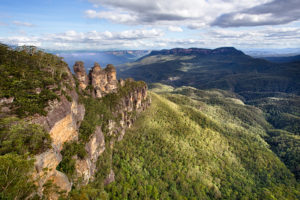
The picturesque Blue Mountains in New South Wales, Australia.
Project Background
In 1993, the 3.4 m (11 ft) diameter TBM was chosen to bore two sewage tunnels in the Blue Mountains near Sydney, Australia. At the time, there had been a rapid expansion of urban developments within the Blue Mountain National Park, causing an influx of pollution to enter streams as the result of septic tank runoff and outdated sewage treatment plants.

A closer look at the Three Sisters, a unique rock formation in the Blue Mountains.
The Blue Mountains Sewage Transfer Project comprised of approximately 40 km (25 mi) of tunnels, two of which were TBM-driven using the Robbins machine. The first, the Katoomba Carrier tunnel, was 13.4 km (8.3 mi) long and the second, the Lawson Carrier, was 3.5 km (2.1 mi) long. While the Lawson Carrier tunnel was finished five weeks prior to the expected completion date, it was during the Katoomba Carrier tunnel that all three records were set. During excavation the machine set the following world records: best day of 172.4 m (565.6 ft), best week of 702.8 m (2,305.7 ft), and a best monthly average of 1,189 m (39,000 ft) within its size range of 3 to 4 m (9.8 to 13.1 ft) diameter machine. Two of those records—the best day and best week—are the fastest ever recorded and have yet to be surpassed by any TBM of any size.
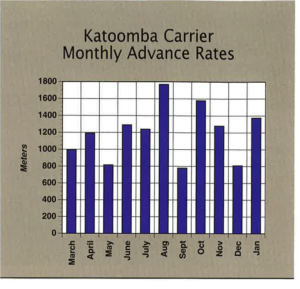
The 3.4 m (11 ft) diameter TBM set three world records while boring the Katoomba Carrier tunnel. Photo credit: tunneltalk.com
Custom Machine Design
There were many factors that played into this machine’s success—the system utilized on this project required a well-planned design, careful operation, and regular maintenance. As many people involved in tunneling know, choosing the right equipment for the geology can make or break a project. Detailed empirical data allowed the contractor to accurately predict what kind of ground they would encounter and prepare accordingly. The National Park is located within the Triassic Sydney Sedimentary Basin and is comprised primarily of sandstones and claystones. Anticipating this geology, the 3.4 m (11 ft) diameter machine’s cutterhead was dressed with 25 Robbins 17-inch diameter disc cutters designed for soft yet abrasive rock formations.
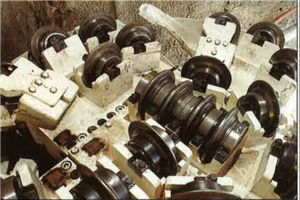
A close-up of the 17-inch cutters.
Logistics
The 13.4 km (8.3 mi) long Katoomba Carrier tunnel was originally planned to comprise of multiple short tunnels, several kilometers in length each, with intermittent portals to shorten drives. Ultimately it was decided to make the project one continuous tunnel, which led to higher advance rates and deemed it—at the time—the longest single-drive TBM tunnel. Not only did this change save time, but it also allowed boring to be less disruptive to the landscape.
Continuous Conveyor
In addition, the project was the first in Australia to utilize a continuous conveyor system. Due to the length of the tunnel, the use of traditional muck cars for muck removal would have taken too much time and were seen as an inadequate solution. The 106-m (347.8 ft) long system boosted production rates, with a best day of 1,565 m³ (55,267 ft³) of in-situ material removed from the Katoomba tunnel.
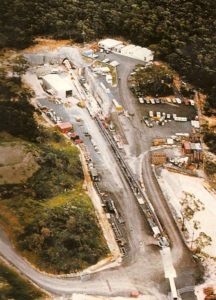
The Blue Mountains project was the first TBM-driven tunnel in Australia to utilize a continuous conveyor system.
Good Geology
Ground support throughout the tunnel comprised of a combination of resin grouted bolts, mesh, steel straps and steel sets. In the sturdier sandstone, however, the tunnel was left largely unlined and instead shotcrete was applied to areas of poorer, softer rock.
As boring progressed, the sandstone proved to be softer than expected. Instead of the predicted average of 80 MPa ranging from 20 MPa to 150 MPa, it averaged 40 MPa to 50 MPa with a range of 10 MPa to 100 MPa. This ideal material could also have contributed to the Robbins machine’s record breaking results and its early breakthrough, which occurred nine months ahead of schedule.
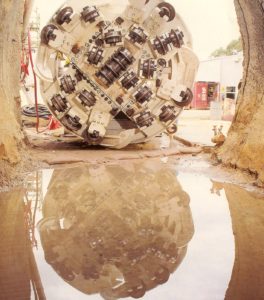
The machine’s record breaking boring enabled the project as a whole to finish 17 months ahead of schedule.
Exceeding Expectations
The Robbins Mk 12C’s performance on the tunnel boring portion of the project substantially surpassed all expectations. Not only did it set the previously mentioned world tunneling records, but it also helped the project as a whole finish 17 months ahead of schedule, saving not only on time but on significant financial costs.

 Close
Close  Menu
Menu 